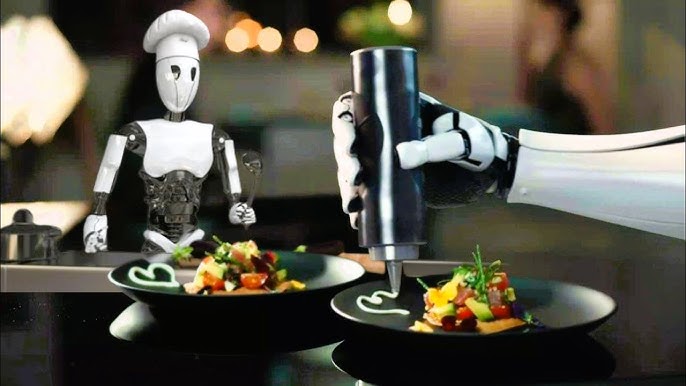1. The Rise of Automated Kitchens 🌍
Robot chefs are being deployed globally to tackle labor shortages, reduce errors, and cut costs:
Botinkit (Shenzhen) developed Omni, a touchscreen-operated robot that stir-fries, stews, seasons, and cleans—all with minimal supervision. It can reduce labor costs by ~30% and food waste by ~10% Interesting Engineering+14The Sun+14World Economic Forum+14OysterLink+1AI for Good+1Food & Wine+3Axios+3Rest of World+3.
In South Korea, highway rest-stop kitchens use Samsung-built bots that cook ramen, sprinkle toppings, and deliver bowls via conveyor belts. Although support staff remain necessary, bots run the heavy lifting to ensure 24/7 service Rest of World.
Hestia Technology in Hong Kong plans to deploy 30,000 robots capable of preparing 200+ dishes (Chinese, Italian, and more) in just minutes—highlighting the scalability of robotic cooking Interesting Engineering.
2. Real-World Deployments
From fast food to fine dining support, these machines are cooking more than pancakes:
CaliExpress by Flippy (Pasadena): Fully robotic grill and fry stations serving burgers, fries—and an end to human burn risks and scheduling woes Gourmet Food Finder+15World Economic Forum+15Tapscape+15The Wall Street Journal+4iHeart+4Forbes+4.
E Vino Spaghetti (Tokyo): P‑Robo handles pasta—including boiling, saucing, and pan-stirring—at 90 meals/hour with strict consistency OysterLink+3Food & Wine+3Food Tech Mentorship+3.
BOTS&POTS Sci‑Food Bistro (Zagreb): GammaChef prepares diverse one-pot meals (e.g., curries, pastas, gnocchi), producing ~100 servings/hour and reducing food waste by 20% with higher customer satisfaction Food Tech Mentorship+1Forbes+1.
Sweetgreen’s Infinite Kitchen (US): Robotic salad assembly line that can output 500 bowls/hour—cutting wait times by 15% and boosting orders by 10% South China Morning Post+2Food Tech Mentorship+2Forbes+2.
RoboChef: A cloud-based, customizable robotic chef franchise operating in Dubai and Singapore, enabling tailored meals delivered in minutes with 25% repeat customer growth FIU News+2Food Tech Mentorship+2Forbes+2.
3. How Many Dishes Can a Robot Chef Master?
While classic burger-flipping bots like Flippy churn out up to 300 patties/hour Forbes+3Mise En Place Tech LLC+3Tapscape+3, advanced systems such as Hestia’s are capable of preparing 200+ dishes—and labs are working on modular robots like YORI that can handle multiple recipes simultaneously Interesting Engineering+1arXiv+1.
In campus environments, robots like Beastro at Florida International University can cook 70–100 variations on-demand and produce 600 meals/day FIU News. So, reaching the 100-dish benchmark? No longer fantasy—it’s becoming everyday reality.
⚖️ Pros & Cons
| ✅ Benefits | ⚠️ Challenges |
|---|---|
| 24/7 operation with zero fatigue | High upfront cost ($50K–$100 K per unit) Tomorrow Desk |
| Perfect consistency and portion control | Limited to standardized menus |
| Reduced labor expenses and waste | Lacks human creativity and cultural nuance |
| Enhanced kitchen safety and hygiene | Technical glitches can disrupt service |
Experts agree on a hybrid future—robots will take on repetitive tasks while human chefs focus on creativity, presentation, and final touches Smithsonian Magazine+12OysterLink+12Tapscape+12.
🔮 The Future of Dining
Cloud-kitchens and delivery-focused operations are perfectly suited to robot chefs—fast, reliable, efficient Dreamstime+1iHeart+1.
As costs drop, even home kitchens could adopt modular cook-bots embedded in countertops Tomorrow Desk+1arXiv+1.
Culinary education may evolve—chefs learning to automate menus, design robot-friendly recipes, and manage robotic kitchen teams.
🧭 Final Thoughts
Robot chefs are no longer sci-fi; they’re thoroughly reshaping how we produce, experience, and enjoy food. With the ability to cook over 100 dishes in real-world settings, they offer consistency, efficiency—and a glimpse into a new culinary era.
Curious about startup models, kitchen integration costs, or human-robot collaboration stories? I can dive deeper—just say the word!





